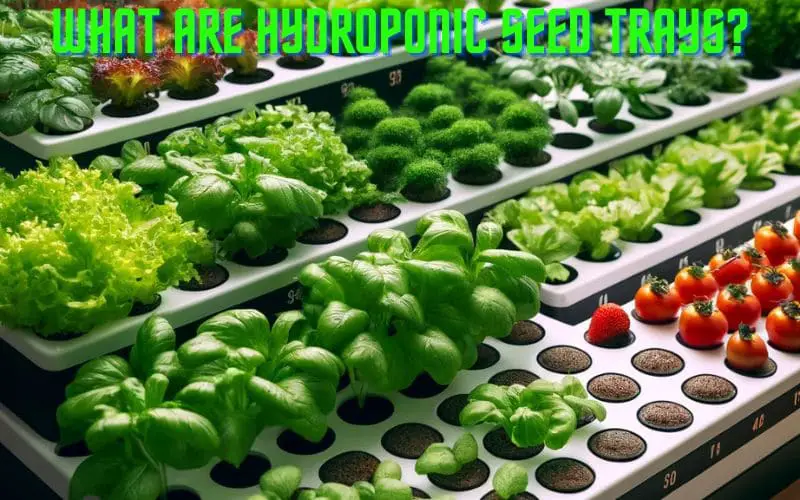What Are Hydroponic Seed Trays? We Dive In And Find Answers!

Introduction
Hydroponic seed trays are a key component of soilless agriculture, offering a revolutionary method for nurturing and cultivating plants. This innovative approach eliminates the need for traditional soil-based planting, allowing plants to thrive in nutrient-rich water solutions. In this comprehensive guide, we will delve into the various aspects of hydroponic seed trays, from their environmental benefits to maintenance and care, equipping you with the knowledge to harness the potential of hydroponic agriculture.
Answer to the Question
Hydroponic seed trays are specialized containers designed for germinating seeds and nurturing seedlings in a soilless environment. Unlike traditional pots or planters, these trays provide a controlled setting for plant growth, facilitating efficient nutrient uptake and optimal root development. By utilizing hydroponic seed trays, growers can maximize space, conserve water, and cultivate healthy and robust plants.
Benefits of Hydroponic Seed Trays
Environmental Benefits
The utilization of hydroponic seed trays presents a range of environmental benefits, including reduced water consumption, minimal nutrient leaching, and the potential for sustainable farming practices. By eliminating the need for soil, these trays contribute to water conservation and minimize the environmental impact associated with traditional agriculture.
Space Efficiency
Hydroponic seed trays are designed to maximize space utilization and provide a compact and organized system for plant propagation. The space-efficient nature of these trays enables growers to cultivate a larger number of plants in a smaller area, making it an ideal solution for urban and indoor farming. In addition to this, the space efficiency of hydroponic seed trays offers several benefits:
- Optimal Use of Vertical Space: Hydroponic seed trays allow for efficient use of vertical space, making it possible to grow an abundance of plants in a limited area.
- Modular Design: The modular design of hydroponic seed trays enables easy stacking and arrangement, further optimizing space utilization.
- Customizable Configuration: Growers can create customized configurations to fit specific spaces, maximizing the use of available area and increasing the overall plant yield.
- Layered Cultivation: Utilizing multiple layers of hydroponic seed trays allows for the cultivation of different plant varieties within the same square footage, maximizing the potential yield per area.
Water Efficiency
Hydroponic systems are known for their exceptional water efficiency, making them an ideal choice for sustainable gardening. Here are some key points to consider:
- Precise Water Delivery: Hydroponic seed trays deliver nutrient solutions directly to the plants’ roots, ensuring minimal water wastage and precise water delivery.
- Optimized Water Usage: The design of hydroponic trays minimizes water usage by recirculating and reusing nutrient solutions, reducing the overall water consumption for plant growth.
- Prevention of Excessive Irrigation: By providing regulated and controlled delivery of water and nutrients, hydroponic systems effectively prevent excessive irrigation, which can lead to water runoff and wastage.
This water-efficient approach not only conserves this vital resource but also promotes sustainable and responsible cultivation practices.
Types of Hydroponic Seed Trays
Tray Material and Design
Hydroponic seed trays are available in various materials, including plastic, styrofoam, and peat. Each material offers distinct advantages in terms of durability, insulation, and water retention. The design of the trays also varies, with some featuring compartments for individual seedlings, while others are designed for continuous growth in a single tray.
Seedling Capacity
The seedling capacity of hydroponic seed trays varies based on the size and configuration of the tray. Growers can choose trays with varying capacities to accommodate their specific requirements, from small-scale herb propagation to extensive plant cultivation.
Automation and Control
Automation and control systems in hydroponic seed trays play a crucial role in optimizing plant growth by providing precise regulation of environmental conditions. These advanced systems offer convenience, efficiency, and greater control for growers, ultimately leading to healthier and more productive plants.
- Temperature Regulation: Automated systems maintain ideal temperature levels, ensuring that plants thrive in a consistent and controlled environment.
- Humidity Control: The automation feature allows for the adjustment of humidity levels, promoting optimal growing conditions and reducing the risk of mold and mildew.
- Nutrient Delivery: Precise automation of nutrient delivery ensures that plants receive the necessary elements for healthy growth, minimizing wastage and maximizing nutritional uptake.
- Lighting Management: Some advanced trays integrate automated lighting controls, facilitating customizable light cycles to mimic natural conditions and enhance photosynthesis.
Furthermore, these systems can be programmed to monitor and adjust environmental parameters based on specific plant requirements, creating an ideal growth environment tailored to the needs of different crops. This level of automation not only saves time and effort for growers but also contributes to consistent and higher crop yields, making it a valuable investment for modern hydroponic cultivation.
How to Choose the Right Hydroponic Seed Tray
Seedling Type and Size
When selecting a hydroponic seed tray, it is essential to consider the type and size of the seedlings you intend to cultivate. Different plant species require specific tray configurations to ensure adequate space and support for healthy growth.
Growing Environment
The environmental conditions in which the hydroponic seed tray will be placed play a pivotal role in tray selection. Factors such as temperature, humidity, and available space should be taken into account to create an optimal growing environment for the seedlings.
Budget Considerations
When it comes to selecting the right hydroponic seed tray, budget considerations play a crucial role in the decision-making process. Evaluating budgetary constraints is essential as different types and features of seed trays may vary in cost. It is important to strike a balance between quality and affordability to ensure that the chosen tray meets both functional and financial requirements.
- Initial Investment: Consider the initial cost of the seed tray, including any additional components or accessories required for its use.
- Long-Term Value: Assess the long-term value provided by the seed tray in terms of durability, reusability, and overall cost-effectiveness.
- Material Quality: Take into account the quality of materials used in the construction of the seed tray, as this can impact its performance and longevity.
- Customization Options: Explore whether the seed tray offers customization options that align with specific growing needs without compromising the budget.
- Comparative Analysis: Conduct a comparative analysis of different seed tray options to determine the best fit in terms of features, quality, and cost.
Maintenance and Care of Hydroponic Seed Trays
Cleaning and Sanitizing
Maintaining clean and sanitized hydroponic seed trays is essential for preventing the buildup of algae, fungi, and pathogens. Regular cleaning and sterilization routines ensure the longevity of the trays and promote a hygienic environment for plant growth.
- Use a gentle soap or mild detergent to clean the trays
- Rinse thoroughly with clean water after cleaning
- For sanitization, use a diluted bleach solution or hydrogen peroxide
- Allow the trays to air dry completely before using them again
Nutrient Management
Effective nutrient management is critical for sustaining healthy plant growth in hydroponic seed trays. Growers must carefully monitor and adjust nutrient solutions to meet the specific requirements of the plants at different growth stages, promoting robust and flourishing vegetation.
- Understanding Nutrient Requirements: Different plant species have varying nutrient needs. It’s important for growers to research and understand the precise nutrient requirements for the specific plants they are growing in hydroponic trays.
- Monitoring Nutrient Levels: Regular pH and electrical conductivity (EC) measurements are essential to ensure that plant nutrient levels are within the optimal range. By closely monitoring these levels, growers can make timely adjustments to maintain healthy plant growth.
- Hydroponic Nutrient Solutions: It’s crucial to use high-quality nutrient solutions specifically formulated for hydroponic systems. These solutions provide the necessary macro and micronutrients essential for vigorous plant development.
- Adjusting Nutrient Solutions: As plants progress through different growth stages, their nutrient requirements change. Growers should be prepared to adjust the composition and concentration of nutrient solutions to meet the evolving needs of the plants.
- Managing Nutrient Imbalances: Imbalances in nutrient levels can lead to stunted growth, wilting, or leaf discoloration. Growers must be vigilant in identifying and addressing any nutrient imbalances to maintain the overall health of the plants.
Troubleshooting Common Issues
Hydroponic seed trays require diligent care to ensure optimal plant growth. Addressing common issues is crucial for maintaining the health of the plants. Let’s explore the common issues and their troubleshooting methods:
- Root Rot: Root rot is a common issue in hydroponic systems caused by fungal pathogens. It can lead to wilting, browning of roots, and stunted growth. To prevent and address root rot, consider the following:
- Implement proper ventilation to maintain adequate oxygen levels in the root zone.
- Monitor and maintain the appropriate nutrient solution temperature.
- Use beneficial bacteria and fungi products to promote a healthy root environment.
- Nutrient Deficiencies: Nutrient deficiencies can hinder plant growth and development. Common deficiencies include nitrogen, phosphorus, potassium, and micronutrients. Here are some steps to address nutrient deficiencies:
- Regularly monitor and adjust the nutrient solution based on plant growth stages.
- Conduct regular water tests to ensure the nutrient solution’s pH and EC levels are within the optimal range.
- Consider foliar feeding with micronutrient solutions to address immediate deficiencies.
- pH Imbalance: Fluctuations in pH levels can disrupt nutrient availability and lead to nutrient lockout. Maintaining the correct pH range is essential for healthy plant growth. Here’s how to manage pH imbalance:
- Regularly test the pH of the nutrient solution and adjust as needed using pH-up or pH-down solutions.
- Utilize pH buffering agents to stabilize the pH levels and prevent drastic fluctuations.
- Ensure that the growing medium is within the appropriate pH range for the specific plant species.
By addressing these common issues promptly and effectively, you can sustain the optimal growth and vitality of plants in hydroponic seed trays.
